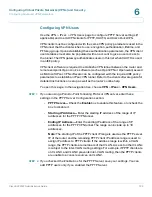
Configuring Virtual Private Networks (VPNs) and Security
Configuring VPNs
Cisco RV220W Administration Guide
107
6
Configuring VPNs
A VPN provides a secure communication channel (“tunnel”) between two gateway
routers or a remote worker and a gateway router. You can create different types of
VPN tunnels, depending on the needs of your business. Several scenarios are
described below. Read these descriptions to understand the options and the
steps required to set up your VPN.
•
Site-to-Site Access with Gateway-to-Gateway VPN, page 107
•
Remote Access with an IPsec Client (Client-to-Gateway VPN), page 107
•
Remote Access with Clientless SSL VPN, page 108
•
Remote Access with Cisco QuickVPN, page 109
•
Remote access using PPTP, page 109
Site-to-Site Access with Gateway-to-Gateway VPN
A gateway-to-gateway VPN connects two or more routers using an IPsec policy to
secure traffic between two sites. Use this type of VPN if you need to connect the
network at a branch office to the network at your main office, for example.
1. Use the
Basic VPN Setup
page to create a VPN. Choose Gateway as the peer
type, and enter a connection name, pre-shared key, remote gateway, local
gateway (should be pre-populated), remote LAN, and local LAN. You will need
to configure the corresponding settings on the router at the other site. See
Basic
VPN Setup, page 109
.
2. If needed, edit the default settings by using the
Advanced VPN Setup
page.
See
Configuring Advanced VPN Parameters, page 111
.
Remote Access with an IPsec Client (Client-to-Gateway VPN)
In this scenario, a remote client, such as a PC running IPsec VPN client software,
initiates a VPN tunnel. The IP address of the remote PC client is not necessarily
known in advance. The gateway acts as responder. Configure this type of VPN
tunnel if you have a teleworkers who need to securely connect to your network
from their home offices, for example.
You will need to configure this router with the specific IPsec policies required for
the IPsec client. You also will need to install and configure the IPsec client
software on the users’ computers.




































